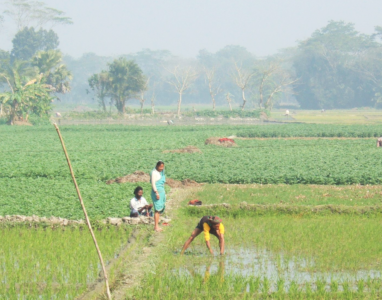
A recent study published by International Potato Center scientists Marcel Gatto and Guy Hareau suggests that smallholder farmers can add a round of potato crop between rice seasons to give their families more food from the same area of land. In addition, household incomes can increase from selling the additional produce or by spending less money on food for the family.
Gatto and Hareau conducted their study to observe the potential for “sustainable intensification” of agriculture in India and Bangladesh, where food and nutrition security remain problematic even though arable land is available for cultivation. Because new and improved potato varieties have short growing cycles, they can fit in the fallow period between rice seasons.
However, as an initial study, the authors stress the need for field and experimental research to determine more precisely the type and magnitude of trade-offs required to grow the extra cycle of crops. For example, fallow land is typically a time when the soil renews itself; growing potatoes would mean more inputs of fertilizer and pesticide into the soil, which could have negative environmental impacts in terms of run-off.
Gatto – an agricultural economist by training – says there are also challenging questions regarding the labor needed to support sustainable intensification. Typically, fallow periods are times when men and women might find alternative employment away from the farm or devote time to household needs. Growing an extra round of crops requires labor to sow and harvest the produce.
This dynamic could be positive in that there will be more employment available for the community. But it could also have negative effects, especially for women for whom the additional crop could become an added burden to their workload.
The solution, Gatto says, is balance: the benefits of the additional food and income source need to be weighed against the additional inputs for growing more crops and the unintended negative environmental effects. That balance can be achieved by improving farming practices such as mulching, zero tillage, integrated pest management, and partial root zone drying to maximize efficient water use. In terms of labor, the balance requires more analysis to determine the food and income benefits of more potatoes against the availability of labor to harvest that crop while maintaining other household obligations.
This study on sustainable intensification is the first of its kind in Asia, and Gatto says future research will focus on collecting evidence to understand how sustainable intensification affects the mentioned constraints at the plot and household levels and up to the environment and landscape levels. At larger scales, Gatto notes, sustainable intensification could have a transformative impact on rural areas through its ability to produce more food, which could be translated to more income and greater need for remunerated labor.
The study was undertaken as part of the CGIAR research program on Policies, Institutions and Markets (PIM), and funded in part by the CGIAR research program on Roots, Tubers and Bananas (RTB).
Open access to the full article is available here.
